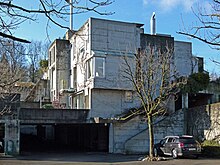brutalism

Brutalism is a modern architectural style that spread from 1950 onwards. The term has its origins in the French béton brut ('raw concrete', exposed concrete), with which Le Corbusier described his preferred material. The term New Brutalism, coined by Reyner Banham , originally stood for an architecture that had the idealized claim to be honest about materials and construction and ethical about the social aspects of architecture.
Today the term is less narrowly defined and stands for the dominant architecture between around 1960 and the beginning of the 1980s. It is now received mostly negatively. Brutalism is characterized by the use of exposed concrete , the emphasis on the construction, simple geometric shapes and mostly very rough elaboration and structuring of the buildings.
history
New Brutalism (1953-1966)

In 1953, the team of architects Team 10 was founded, which later coined the term 'New Brutalism' to differentiate it from Le Corbusier. It was first mentioned in December 1955 in Architectural Review by Reyner Banham . Despite the emphasis on concrete, this style also allows other materials such as metal, brick or stone. An example of this style is the Hunstanton School by Alison and Peter Smithson from 1949–1954, a brick building with visible supply lines.
brutalism
Brutalism was linked in a specific way to the economic and material, but especially to the mental and psychological situation of the post-war period. On the one hand, this made it an international phenomenon, but on the other hand it was based on local conditions. Brutalism spread to all continents in the 1960s and remained present until the 1980s. The representatives of this type of construction believed that modern industrialized societies need art that is as powerful as possible. They should “experience spiritual liberation, be made to see, experience sensuality instead of commerce”. This is also expressed in the underlying French word “brut” in that it not only means “raw”, but also “rough”, “coarse”, “tart” or “honest”.
In the 1990s, the architectural style fell into disrepute, the architects and town planners now pursued a kind of rebirth of the bourgeois city, brutalism was seen as "aesthetic vandalism". This impression was reinforced by the fact that the buildings in question did not appear to be well maintained, and the concrete was more susceptible to dirt, algae growth or decay than expected.
It was not until the beginning of the 21st century that a phase of rediscovery of brutalism began, especially in the face of demolitions or disfiguring renovations.
Examples from different countries and continents
Settlements and building complexes
Not only individual buildings belong to Brutalism, entire settlements or educational complexes were created under the influence of this style.
To be mentioned here are:
- numerous buildings in the prefabricated housing estate at Ernst-Thälmann-Park in Berlin-Prenzlauer Berg , completed in the 1980s and now listed
- the Bijlmermeer housing estate near Amsterdam , architect Siegfried Nassuth , 1968
- Parts of Berlin's Gropiusstadt
- some residential neighborhoods in the suburbs of Paris as well
- the Thalmatt and Halen settlement of Atelier 5 in Switzerland.
- Pictures (selection)
Entrance page of the Markuskyrkan in Stockholm ( Sigurd Lewerentz , 1958–1963)
Bank of London & South America,
in Buenos Aires
( Clorindo Testa , 1959)Scarborough College Ontario , Canada ( John Andrews , 1963–1969)
Reconciliation Church (Dachau) ( Helmut Striffler , 1965–1967)
Hotel Meliton of the Porto Carras complex , Chalkidiki
( Walter Gropius , posthumously 1973)Genex Tower , Belgrade
( Mihajlo Mitrović , 1980)Russian Embassy Havana
(A. Rotschegow, 1985)St. Francis Catholic Church on Malta by Richard England
St. Gallus Church in Lichtensteig , (1968–1970), Walter Maria Förderer
Exhibitions
- 2017/2018: SOS Brutalism - Save the Concrete Monsters , German Architecture Museum in cooperation with the Wüstenrot Foundation , Frankfurt am Main.
- 2018/2019: Brutally modern. Building and living in the 60s and 70s , in the Braunschweigisches Landesmuseum .
literature
- Reyner Banham: Brutalism in Architecture. Ethics or aesthetics? Karl Krämer Verlag Stuttgart 1966.
- Jürgen Joedicke: For a living architecture . Karl Krämer Verlag, Stuttgart.
- Peter Chadwick: This brutal world , Phaidon Verlag , 2016.
- Richard Hoppe-Sailer: Ruhr University Bochum, architectural vision of post-war modernism , Gebr. Mann-Verlag, Berlin, 2015, ISBN 3-7861-2744-1 .
- Katrin Keßler, Heike Pöppelmann (eds.): Brutal modern. Building and living in the 60s and 70s. Small series of the Braunschweigisches Landesmuseum Volume 11, Braunschweig 2018, ISBN 978-3-9820340-0-3 .
Web links
- German Architecture Museum Frankfurt: "SOS Brutalism - Save the Concrete Monsters!"
- open2.net: Brutalism - A human modernism ( Memento from April 21, 2007 in the Internet Archive )
- Luigi Monzo: Not you Brutus! or the birth of exposed concrete .
- Page of a symposium in May 2012 entitled Brutalism. Architectures between everyday life, poetry and theory
- Google Community "Architecture of Brutalism" (German and English) - large collection of links and many current photos
- Luigi Monzo: Beyond Pure Form - Thoughts on a Concept of Proto-Brutalism.
Individual evidence
- ↑ a b c SOS brutalism. An international inventory . Park Books, Zurich 2017, ISBN 978-3-03860-074-9 , pp. 15th ff .
- ^ Reyner Banham: The New Brutalism . In: Architectural Review , 12/1955.
- ↑ a b c d e Nikolaus Bernau: In love with concrete monsters , January 3, 2018; Print edition: Promises made of concrete. Despised for three decades, now celebrated: Brutalism is undergoing rehabilitation for many reasons . In: Berliner Zeitung , January 4, 2018, p. 23.
- ↑ Jörg H. Gleiter: Brutalism as a symptom. Japanese architecture after 1950 Archived from the original on August 28, 2012. In: ARCH + . No. 208, August 31, 2012, pp. 6-9.
- ↑ Brutal beautiful in Frankfurter Allgemeine Sonntagszeitung on November 12, 2017, p. 49.
- ↑ SOSBrutalism . Initiative of the German Architecture Museum and the Wüstenrot Foundation
- ^ Exhibition Brutal modern in the Braunschweigisches Landesmuseum
- ↑ Bettina Maria Brosowsky: Is that architecture or can it be eliminated? on taz.de.











